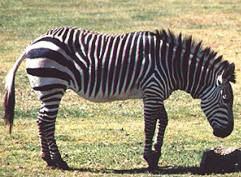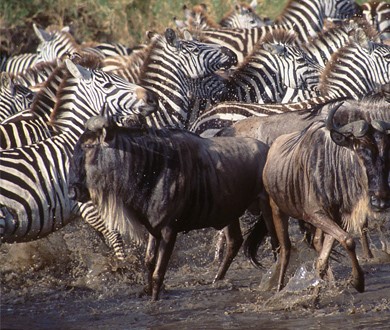Equus burchelli (Plains Zebra) -BIO203
Social Structure/ Interactions
The Plains Zebra is a very social animal it has two types of social
structures a loose herd structure and a tight harem structure
(Rubenstein & Hack 2004). These different structures make life on the
plains interesting for the Plains Zebra. This ties well into the
interactions between zebras and transitions well into the interactions
with other plains animals.
 The first
social structure I would like to talk about is the tight harem structure
(Rubenstein 1986). According to Merriam Webster a harem is a group of
females associated with one male —used of polygamous animals. The
females in this harem are have a very close social structure even though
may have some competition for food. The harems that Equus burchelli form
are different from most other harems like
lions
because the females in the harem are not all related they are all from
different natal harems (Hack et. al. 2002). The reason for these harems
is mainly for protection. The large numbers of animals in the group are
a much more formidable force against predators such as the
leopard.
A social structure such as our own with a male, female, and their
offspring would not last long on the plains; they would be picked off
one by one by predators (Rubenstein & Ha
The first
social structure I would like to talk about is the tight harem structure
(Rubenstein 1986). According to Merriam Webster a harem is a group of
females associated with one male —used of polygamous animals. The
females in this harem are have a very close social structure even though
may have some competition for food. The harems that Equus burchelli form
are different from most other harems like
lions
because the females in the harem are not all related they are all from
different natal harems (Hack et. al. 2002). The reason for these harems
is mainly for protection. The large numbers of animals in the group are
a much more formidable force against predators such as the
leopard.
A social structure such as our own with a male, female, and their
offspring would not last long on the plains; they would be picked off
one by one by predators (Rubenstein & Ha ck
2004). The leadership of the harem is in charge of deciding where to
forage. The lactating females in the harem need to be close to some sort
of water to sustain themselves and their offspring, but the zebra also
need adequate area to graze on for food so it is sometimes a struggle
(Fischhoff et. al. 2006) There are even known to stay together after a
single mare (male) has left the group (Rubenstein & Hack 2004). This is
similar in most species of zebras like the
Grevy’s Zebra. There are also groups of males that get into
“bachelor groups” that use the same ideas of harems; they use these
large groups to protect themselves from predators. Also Plains Zebra
males can be part of the larger herd that includes themselves and a
number of harems. These harems also can mix into large groups called
herds which lead into my next social structure.
ck
2004). The leadership of the harem is in charge of deciding where to
forage. The lactating females in the harem need to be close to some sort
of water to sustain themselves and their offspring, but the zebra also
need adequate area to graze on for food so it is sometimes a struggle
(Fischhoff et. al. 2006) There are even known to stay together after a
single mare (male) has left the group (Rubenstein & Hack 2004). This is
similar in most species of zebras like the
Grevy’s Zebra. There are also groups of males that get into
“bachelor groups” that use the same ideas of harems; they use these
large groups to protect themselves from predators. Also Plains Zebra
males can be part of the larger herd that includes themselves and a
number of harems. These harems also can mix into large groups called
herds which lead into my next social structure.
The herd social structure of Equus burchelli is a rapidly changing group
that does not seem to have a particular order in social structures.
Herds are groups of harems and bachelor males that can change in a
matter of hours or days (Fischhoff et al. 2009). These herds are another
way that the plains zebra protects themselves from the many predators on
the plains such as
cheetahs.
These herds are not just full of zebras they are also filled with all
types of other plains animal.
To learn more about the significance of the hierarchy and social
structure of the plains zebra click
here to explore the team at
Princeton studying plains zebra.

A species that is seen with plains zebras a lot is the blue wildebeest
a similar herbivore. These two species have a symbiotic relationship in
which they both help each other with detecting predators (Boer & Prins
1989). They live in rather close proximity to each other on the plains
but the close proximity does have some draw backs. The competition for
similar food is a stronger force than the fear of predators in the dry
season when food is scarce, so the plains zebra put more distance
between themselves and the wildebeest (Shorrocks 2007). Shorrocks also
hypothesizes that the zebra try to stay close to the wildebeest because
they slower wildebeest is an easier prey for the large carnivores of the
plains. Other than the wildebeest the plains zebra interact with a lot
of other grazing herbivores on the savannah like the
giraffe
and African
elephant. The interactions between Equus burchelli and the large
predator of the plains is a prey-predator relationship. The plains zebra
is the regular prey of lions, leopards, cheetahs, hyenas, and Nile
crocodile (Cavendish 2010). This is particular higher with lions which
account for the most zebra deaths (Fischhoff et al.2007). The zebra does
have some advantages it is always hyper vigilante from these predators.
(Periquet et. al. 2010). Other interactions of the plains zebra are the
Strongyloides sp. or the threadworm is a parasite that lives in the
small intestine (Fuggazola & Stancampiano 2012). This was recorded by
Fuggazola from fecal samples to determine if rank in the harem affected
the amount of parasites the zebra had, the results were conclusive with
his hypotheses. The zebra is an herbivore on the food chain so it is in
the intermediate part of the chain because of its large size only large
predators or a group of predators can take this prey down.